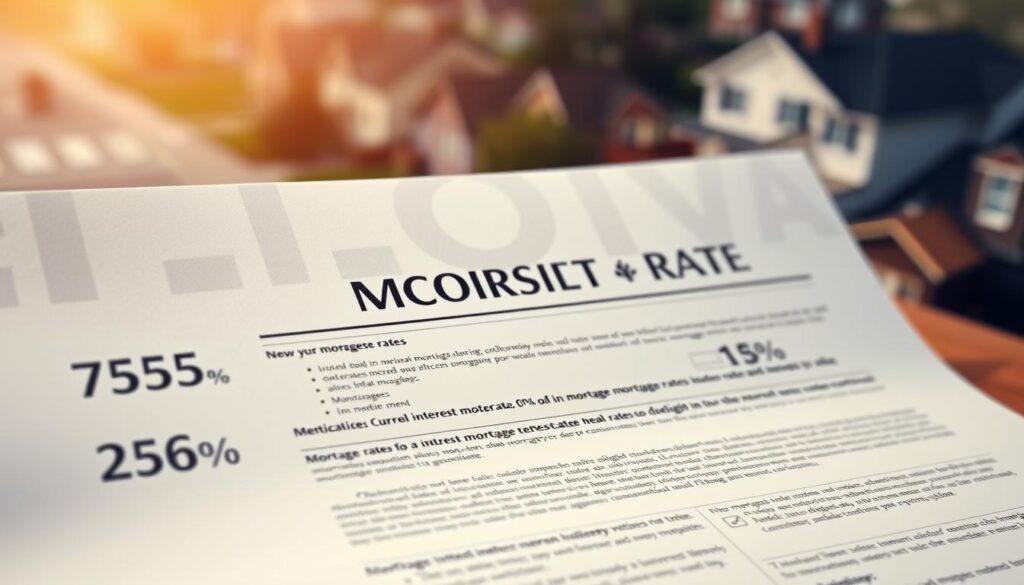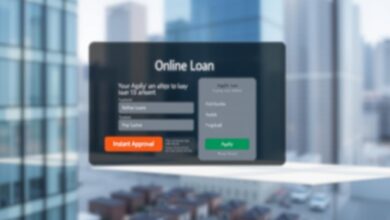Explore Flexible Home Loan Options Today
The mortgage world is changing fast. Over 8 million homeowners in the U.S. have refinanced in the last year. This shows how key it is to know about the different home loan choices out there.
We aim to give lenders a wide range of affordable mortgage options. This helps more people get the financing they need to buy or own a home. We also offer mortgage rates that are competitive, which can really lower the cost of a loan.
Using a loan calculator is a smart move. It helps people understand what they might have to pay for a loan.
Key Takeaways
- Flexible home loan options are crucial in today’s mortgage market.
- Understanding mortgage rates can significantly impact loan costs.
- A loan calculator is a valuable tool for potential borrowers.
- We’re committed to expanding access to financing for homebuyers.
- Competitive mortgage rates are available for those who know where to look.
Understanding Home Loans: A Comprehensive Overview
There are many home loan options out there. It’s important to understand the basics to pick the right one for you. With so many mortgages to choose from, it can feel overwhelming.
We’ll cover the key aspects of home loans to help you make a smart choice. Knowing the different types and their benefits is key in today’s housing market.
What is a Home Loan?
A home loan, or mortgage, lets you borrow money to buy a home. You agree to make regular payments, which include interest and part of the loan amount.
Home loans are a big financial step. It’s crucial to know the terms and conditions before you sign. Things like home loan eligibility and refinancing options are important in this process.
Key Types of Home Loans
There are many home loan types, each suited for different needs and financial situations. The most common include:
- Fixed-Rate Mortgages: These loans have a fixed interest rate for the entire term.
- Adjustable-Rate Mortgages: The interest rate on these loans can change based on market conditions.
- Government-Backed Loans: Insured by agencies like FHA, VA, and USDA, these loans have more flexible eligibility.
It’s important to understand these options to choose the best loan for you.
| Loan Type | Interest Rate | Repayment Term |
|---|---|---|
| Fixed-Rate | Fixed | 15-30 years |
| Adjustable-Rate | Variable | 15-30 years |
| Government-Backed | Varies | Varies |
Why Consider a Home Loan?
Home loans let you buy a home without paying the full price upfront. They also let you build equity over time and may offer tax deductions on mortgage interest.
Thinking about your home loan eligibility and exploring refinancing options can help you get the most from your mortgage. It’s important to weigh the pros and cons and talk to a financial advisor if needed.
Fixed-Rate vs. Adjustable-Rate Mortgages
Choosing between a fixed-rate and an adjustable-rate mortgage is a big decision. You need to know how each works and which fits your financial situation best. We’ll look at the good and bad sides of each to guide you.
Pros and Cons of Fixed-Rate Mortgages
Fixed-rate mortgages have a set interest rate for the loan’s life. Your monthly payments stay the same. This stability is great, even when interest rates go up.
Advantages:
- Predictable monthly payments
- Protection from rising interest rates
- Easier budgeting and financial planning
Disadvantages:
- Typically higher initial interest rates compared to adjustable-rate mortgages
- Penalties for early repayment
- May be more challenging to qualify for
Pros and Cons of Adjustable-Rate Mortgages
Adjustable-rate mortgages have rates that change with the market. Your monthly payments can go up or down over time.
Advantages:
- Often lower initial interest rates, leading to lower initial monthly payments
- Potential for decreased monthly payments if interest rates fall
- May qualify for a larger loan amount due to lower initial payments
Disadvantages:
- Uncertainty and potential for increased monthly payments
- Risk of significantly higher payments if interest rates rise substantially
- Complexity due to various adjustment mechanisms and caps
To better understand the differences, let’s compare fixed-rate and adjustable-rate mortgages in the following table:
| Feature | Fixed-Rate Mortgage | Adjustable-Rate Mortgage |
|---|---|---|
| Interest Rate | Fixed for the life of the loan | Variable, based on market conditions |
| Monthly Payments | Remain the same | Can increase or decrease |
| Initial Interest Rate | Typically higher | Often lower |
| Risk Level | Lower risk due to predictable payments | Higher risk due to potential payment increases |
Understanding the pros and cons of fixed-rate and adjustable-rate mortgages helps you make a better choice. Think about your financial goals and current market conditions when deciding. This will help you choose the right mortgage for you.
FHA Loans: What You Need to Know
FHA loans are great for many homebuyers, including first-timers. They have easier credit score rules and lower down payments. The Federal Housing Administration (FHA) insures these loans, making homes more affordable for more people.
These loans are perfect for those who can’t get conventional loans. Knowing what FHA loans offer can help you choose the right financing for your home.
Eligibility Requirements
To get an FHA loan, you need to meet some criteria. Here’s what’s required:
- A minimum credit score, which can be lower than conventional loans.
- A stable income and job history.
- A debt-to-income ratio within FHA limits.
- The property must be your primary home.
Credit Score Requirements: FHA loans don’t have a strict minimum credit score. But, most lenders want a score of 580 for the lowest down payment. You can still qualify with a lower score, but you’ll need to put down more money.
Benefits of FHA Loans
FHA loans have many benefits for homebuyers. Here are some key advantages:
- Low Down Payment: FHA loans can have down payments as low as 3.5%.
- Lenient Credit Requirements: FHA loans are more flexible with credit scores, helping those with less-than-perfect credit.
- Lower Mortgage Insurance: FHA mortgage insurance premiums are often lower than private mortgage insurance for conventional loans.
Here’s a comparison of FHA loan benefits:
| Loan Feature | FHA Loans | Conventional Loans |
|---|---|---|
| Minimum Down Payment | 3.5% | 5% – 20% |
| Credit Score Requirements | 580+ | 620+ |
| Mortgage Insurance | Required, with premiums varying by down payment and loan term | Required for down payments less than 20%, with premiums based on credit score and loan term |
Exploring FHA loans can open up more financing options for homebuyers. Whether you’re buying your first home or refinancing, understanding FHA loans can help you make the best choice for your finances.
VA Loans: A Unique Option for Veterans
VA loans are a special way for veterans and military folks to own a home. These loans are backed by the Department of Veterans Affairs. They offer good terms that help make buying a home easier.
Who Qualifies for VA Loans?
VA loans are for eligible veterans, active-duty people, and surviving spouses. To qualify, you must meet certain service requirements. These requirements depend on your service type.
Usually, veterans who served during wartime or peacetime qualify. Also, those who were discharged without dishonorable conditions are eligible.
It’s important to know about home loan eligibility. Veterans can check their status with the Department of Veterans Affairs or a VA-approved lender.
Key Benefits of VA Loans
VA loans have great refinancing options. You can refinance to lower your interest rate or switch to a fixed-rate loan. Plus, VA loans often don’t require a down payment, which helps if you don’t have a lot of savings.
They also have lower interest rates than regular loans and don’t need a high credit score. And, you won’t have to pay private mortgage insurance (PMI), which saves money each month.
Knowing about VA loans’ eligibility and benefits helps veterans and military folks make smart choices about their home financing.
USDA Loans: Helping Rural Homebuyers
Homebuyers in rural areas can get USDA loans. These low down payment loans are backed by the United States Department of Agriculture. They offer good terms, making it easier for those who find it hard to get conventional loans.
USDA loans are for those who want to buy homes in rural areas. To qualify, you must meet certain requirements.
Understanding USDA Loan Eligibility
To get a USDA loan, the property must be in a rural area. The borrower’s income also matters. It can’t be more than the area’s moderate income limit.
Use the USDA’s online map to check if a property is in a rural area. This tool helps find out if a property qualifies.
Features and Benefits of USDA Loans
USDA loans have great features like low interest rates and zero down payment requirements. These benefits help borrowers qualify for a home loan without a big upfront cost.
- Low interest rates, which can lead to lower monthly mortgage payments.
- No down payment required, reducing the upfront costs of purchasing a home.
- Lower mortgage insurance premiums compared to other low-down-payment loan options.
Knowing about USDA loans’ eligibility and benefits helps homebuyers make smart choices. USDA loans are a great option for those buying homes in rural areas.
How to Choose the Right Home Loan
Starting your journey to homeownership means picking the right home loan. This choice depends on your financial health and credit score. It can feel overwhelming to pick from many mortgage options. But, knowing your finances and credit score helps you make a smart choice.
Assessing Your Financial Situation
First, check your home loan eligibility by looking at your finances. This means checking your income, expenses, savings, and debts. Lenders look at your debt-to-income ratio, aiming for it to be under 36%. This ensures you can handle your monthly mortgage payments.
To begin, collect your financial documents. These include pay stubs, bank statements, and tax returns. They help you see your financial health and find a home price you can afford.

Understanding Your Credit Score
Your credit score is key in getting good mortgage rates. A high score means you’re a low-risk borrower, leading to better rates. But, a low score might mean higher rates or even no loan at all.
Here’s how your credit score affects your mortgage rate:
| Credit Score Range | Typical Mortgage Rate | Loan Terms |
|---|---|---|
| 760-850 | 3.75% | Favorable terms |
| 700-759 | 4.0% | Competitive rates |
| 680-699 | 4.25% | Standard terms |
| 620-679 | 4.75% | Higher rates |
| Below 620 | 5.5% or higher | Less favorable terms or rejection |
Knowing your credit score and its effect on your mortgage rate is crucial. If your score is low, you can work to improve it. This can help you get a better interest rate and better home loan eligibility.
The Home Loan Application Process
Applying for a home loan can seem hard, but it’s easier with the right help. Knowing the steps and having the right documents are key to success.
Steps to Take Before Applying
First, check your finances. Use a loan calculator to see how much you can borrow. This helps you pick the right loan for you.
Your credit score matters too. A good score can help you get approved and may get you better rates. You can get your score from credit agencies and work on it if it’s low.
Documentation Required for Approval
The documents needed vary by lender and loan type. You’ll need proof of income, employment, and ID. Also, financial statements like bank statements and tax returns are required.
If you’re looking at refinancing options, you’ll need more. This includes details of your current loan and the property’s value. Having all your documents ready can speed up the process.
“The mortgage process can be complex, but understanding the requirements and preparing according to them can make a big difference.”
Here’s a quick look at what you might need:
| Document Type | Description | Required For |
|---|---|---|
| Proof of Income | Payslips, bank statements | All Applicants |
| Employment Verification | Letter from employer | All Applicants |
| Identification | ID card, passport | All Applicants |
| Financial Statements | Bank statements, tax returns | All Applicants |
| Property Valuation | Appraisal report | Refinancing Applicants |
Understanding the home loan process and being ready can help you make smart choices. It can also save you time and money. Start with places like Bank of America, which offers a Digital Mortgage Experience for easier applications.
The Role of a Mortgage Lender
A mortgage lender does more than just provide funds. They are a crucial partner in securing the best home loan rates and terms. Knowing your lender’s role can greatly impact your experience and the loan’s financial effects.
How to Choose the Right Lender
Choosing the right mortgage lender is not just about interest rates. It’s about finding someone who understands your needs, offers competitive rates, and provides great service. Consider these factors:
- Experience and Reputation: Choose lenders with a good history and positive reviews.
- Loan Options: Make sure they have a variety of loans, including for first-time buyers.
- Customer Service: Check if they are quick to respond and help you through the process.
Experts say, “Talk to your lending specialist” for advice that fits your situation.
Questions to Ask Your Mortgage Lender
It’s important to ask the right questions to make an informed choice. Some key ones include:
- What are the total costs of the loan, including fees and closing costs?
- Can you explain the different loan types and their benefits?
- How does your loan processing work, and how long does it take to get approved?
- Are there penalties for paying off the loan early, and how are they calculated?
By asking these questions, you can understand your lender’s offerings better and make a more informed choice.
Understanding Interest Rates and Terms
To get the best home loan, knowing about interest rates and loan terms is key. Interest rates, shown as a percentage, greatly affect your loan’s total cost.

Interest rates on loans are crucial for your monthly payments and the loan’s total cost. Understanding how these rates are set helps you make better choices for your home loan.
How Interest Rates Are Set
Home loan interest rates are set by many factors. These include the economy, lender policies, and your credit score. Lenders look at the economy, the risk of lending to you, and the loan term when setting rates.
For example, when the economy grows, interest rates might go up. This is because more people want loans and there’s more inflation. But when the economy slows down, rates might drop to encourage more borrowing.
The Impact of Loan Terms on Payments
The loan term affects your monthly payments and the total interest you’ll pay. Longer terms mean lower monthly payments but more interest over time.
A loan calculator can show you how different terms and rates change your mortgage payments. By trying out different scenarios, you can see the total cost of various loans. This helps you pick the best option for your finances.
For instance, a 30-year mortgage might have lower monthly payments than a 15-year one. But, you’ll pay more in interest over the longer term. It’s important to consider these factors when choosing your loan term.
By understanding mortgage rates and how loan terms affect payments, you can better navigate the home loan process. This way, you can make choices that fit your financial goals.
Common Mistakes to Avoid When Applying
To ensure a successful home loan application, it’s crucial to steer clear of frequent errors. Knowing these common mistakes can save time and reduce stress. We will explore two significant mistakes and provide guidance on how to avoid them.
Overlooking Your Credit History
One of the most critical factors in determining home loan eligibility is your credit history. Lenders use your credit score to assess the risk of lending to you. Overlooking your credit history can lead to unexpected rejections or unfavorable loan terms. It’s essential to check your credit report for any errors or negative marks and work on improving your score if necessary.
Your credit score is calculated based on your payment history, credit utilization, length of credit history, and other factors. A good credit score can significantly improve your chances of getting approved for a home loan with favorable terms. To avoid any surprises, obtain a copy of your credit report and review it carefully before applying.
For instance, if you have outstanding debts or a history of late payments, your credit score may be lower than expected. In such cases, taking steps to rectify these issues can enhance your creditworthiness. This might involve paying off debts, disputing any inaccuracies on your credit report, or simply making timely payments going forward.
Ignoring Closing Costs
Another common mistake is ignoring refinancing options and closing costs associated with your home loan. Closing costs can include fees for appraisal, title insurance, and loan origination, among others. These costs can add up and significantly impact the total cost of your loan. Failing to factor in these expenses can lead to financial strain.
When applying for a home loan, it’s not just the interest rate and monthly payments that you need to consider. Closing costs can range from 2% to 5% of the loan amount, so it’s crucial to factor these into your budget. Understanding all the costs involved can help you make a more informed decision and avoid last-minute surprises.
For example, some lenders may offer to roll closing costs into the loan, but this can increase your debt burden. Others might provide options for refinancing that can help manage these costs more effectively. It’s worth exploring these options and discussing them with your lender to find the best approach for your situation.
By being mindful of these common mistakes and taking steps to avoid them, you can navigate the home loan application process more effectively. Ensuring that you have a good understanding of your credit history and the total costs involved can make a significant difference in your application outcome.
Tips for Getting the Best Home Loan Rate
Getting the best home loan rate can change your financial path. With the right plan, you can save a lot of money over time.
To get the best rate, knowing what affects mortgage rates is key. Experts say, “The key to getting the best rate is not just about finding the lowest rate, but also about understanding the terms and conditions that come with it.”
Shopping Around for Rates
Shopping around is a smart way to find a good home loan rate. Different lenders have different rates based on their policies and your financial situation.
- Compare rates from multiple lenders to find the best deal.
- Consider working with a mortgage broker who can help you navigate the market.
- Check online reviews and ratings to gauge a lender’s reputation.
A financial analyst notes, “Shopping around is crucial because even a small difference in interest rates can lead to significant savings over the life of the loan.”
Negotiating with Lenders
Negotiation is key to getting the best home loan rate. Lenders might adjust their rates or terms if you negotiate well.
To negotiate effectively, you should:
- Be prepared with information about competing offers.
- Highlight your creditworthiness and financial stability.
- Be clear about what you are asking for.
A mortgage expert says, “Negotiation is not just about getting a lower rate; it’s about getting the right terms for your financial situation.”
For more tailored advice, contact a home loan specialist. They can help you through the process.
Conclusion: Start Your Home Loan Journey Today
We’ve covered a lot about home loans. Now, it’s time to move forward and own your dream home. We’re here to guide you every step of the way.
Making Progress After Approval
Once you’re approved for a home loan, you’ll need to finish the mortgage process. This includes agreeing on your loan terms and meeting any extra requirements. First-time buyers can find help with down payments and other home-buying costs.
Additional Resources for Homebuyers
Looking for more help on your homebuying path? Check out resources on home loans and first-time buyer programs. They offer great advice and support as you explore the mortgage world.









